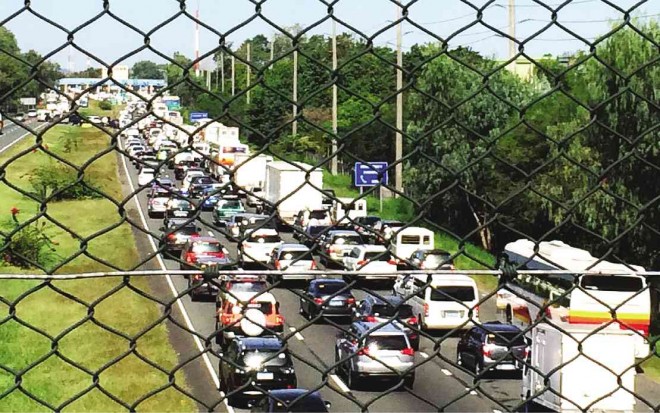
Traffic crawled to the Dau toll plaza along the North Luzon Expressway in Mabalacat City, Pampanga province, on Dec. 26, part of a long holiday weekend. CONTRIBUTED PHOTO
MANILA, Philippines–After spending 11-and-a-half hours on the road to Baguio City, Senate President Franklin Drilon is seeking a Senate inquiry into the “inefficiencies” of the toll collection system at the expressways, which he said exacerbated the traffic situation.
The operator of two expressway networks attributed the traffic congestion to the huge number of vehicles going to Baguio and other popular vacation spots in northern Luzon.
North Luzon Expressway (NLEx), Subic-Clark-Tarlac Expressway (SCTEx) and Cavitex, meanwhile, are issuing advisories to motorists to stagger their journey back to Metro Manila on Jan. 1-4, to avoid heavy congestion at the tollbooths.
Drilon, speaking over dzBB radio, blamed the lengthy road trip to the City of Pines on the need to stop at several tollgates along the way, because different entities handle the collection of fees.
He proposed that the collection of fees be integrated so that only one entity would handle the matter.
The expressways going to the north are NLEx, SCTEx and Tarlac-Pangasinan-La Union Expressway (TPLEx). The three are contiguous. TPLEx is an extension of SCTEx, which in turn is connected to NLEx.
Drilon acknowledged that there were a lot of people traveling to northern Luzon for the holidays and were probably induced to do so by low gas prices.
But the need to stop to pay the toll several times exacerbates the traffic situation and leads to the “extraordinary” traffic buildup at the tollgates, he said.
One hour for 2 km
“It’s an expressway, but when you get to the tollgate it becomes a barangay road,” he said in a separate phone interview. He recalled that it took him one hour to traverse a 2-kilometer stretch leading to one tollbooth.
“The volume was aggravated by the inefficiencies of the system,” he added.
Aside from the kilometric lines leading to the tollgates, there were gates that were too narrow and had too few collection booths.
And despite the long line of vehicles, there was nobody collecting toll payments in advance, he noted.
There were also times when the cashiers at the booths did not have enough change, leading to further delays as they scramble to get the necessary amount, he said.
According to Drilon, integrating the payment system for the toll collection would not be a complex task.
“I can’t understand why the collection of toll fees can’t be integrated, so that only one entity handles the collection,” he said.
“It’s not rocket science,” he added.
If this would be implemented, travelers would need to make fewer stops, he said. Such a move would benefit both private and public utility vehicles, he pointed out.
Spending funds to build larger tollgates would also be money well spent, as it would allow more vehicles to pass through at one time, he further said.
Longest ride
According to Drilon, his nearly half-day trip on Dec. 26 was the longest ride to Baguio that he had experienced. He left San Juan City in Metro Manila at 7 a.m. and arrived in the summer capital at 6:30 p.m.
In contrast, it took him three and a half hours to return from Baguio to Manila Sunday. He left at 5:30 a.m. and was in Metro Manila before 9:30 a.m.
After the holidays, Drilon intends to file a resolution so that the Senate could look into the problems that commuters and motorists face when using the expressways.
“Something must be done about this,” he said.
Originally posted: 9:07 PM | Sunday, December 28th, 2014
RELATED STORIES
Traffic in NLEx mars Christmas Eve travel to provinces
Traffic jams spoil holiday travel to North

